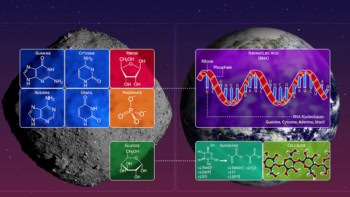
Located about 40 light years from us, the exoplanet Trappist-1 b, orbiting an ultracool dwarf star, has perplexed astronomers with its atmospheric mysteries. Recent observations made by the James Webb Space Telescope (JWST) at two mid-infrared bands (12.8 and 15 µm), suggest that the exoplanet could either be bare, airless rock like Mercury or shrouded by a hazy carbon dioxide (CO2) atmosphere like Titan.
The research, reported in Nature Astronomy, provides the first thermal emission measurements for Trappist-1 b suggesting two plausible yet contradictory scenarios. This paradox challenges our current understanding of atmospheric models and highlights the need for further investigations – both theoretical and observational.
Scenario one: airless rock
An international team of astronomers, co-led by Elsa Ducrot and Pierre-Olivier Lagage from the Commissariat aux Énergies Atomiques (CEA) in Paris, France, obtained mid-infrared observations for Trappist-1 b for 10 secondary eclipse measurements (recorded as the exoplanet moves behind the star) using the JWST Mid-Infrared Instrument (MIRI). They recorded emission data at 12.8 and 15 µm and compared the findings with various surface and atmospheric models.
The thermal emission at 15 µm corresponded with Trappist-1 b being almost null-albedo bare rock; however, the emission at 12.8 µm refuted this model. At this wavelength, the exoplanet’s measured flux was most consistent with the surface model of an igneous, low-silica-content rock called ultramafic rock. The model assumes the surface to be geologically unweathered.
Trappist-1 b, the innermost planet in the Trappist-1 system, experiences strong tidal interaction and induction heating from its host star. This could trigger volcanic activity and continuous resurfacing, which could lead to a young surface like that of Jupiter’s volcanic moon Io. The researchers argue that these scenarios support the idea that Trappist-1 b is an airless rocky planet with a young ultramafic surface.
The team next explored atmospheric models for the exoplanet, which unfolded a different story.
Scenario two: haze-rich CO2 atmosphere
Ducrot and colleagues fitted the measured flux data with hazy atmospheric models centred around 15 µm. The results showed that Trappist-1 b could have a thick CO2-rich atmosphere with photochemical haze, but with a twist. For an atmosphere dominated by greenhouse gases such as CO2, which is strongly absorbing, temperature is expected to increase with increasing pressure (at lower levels). Consequently, they anticipated the brightness temperature should be lower at 15 µm (which measures temperature high in the atmosphere) than at 12.8 µm. But the observations showed otherwise. They proposed that this discrepancy could be explained by a thermal inversion, where the upper atmosphere has higher temperature than the layers below.
In our solar system, Titan’s atmosphere also shows thermal inversion due to heating through haze absorption. Haze is an efficient absorber of stellar radiation. Therefore, it could absorb radiation high up in the atmosphere, leading to heating of the upper atmosphere and cooling of the lower atmosphere. Indeed, this model is consistent with the team’s measurements. However, this leads to another plausible question: what forms this haze?
Trappist-1 b’s close proximity to Trappist-1 and the strong X-ray and ultraviolet radiation from the host star could create haze in the exoplanet’s atmosphere via photodissociation. While Titan’s hydrocarbon haze arises from photodissociation of methane, the same is not possible for Trappist-1 b as methane and CO2 cannot coexist photochemically and thermodynamically.
One plausible scenario is that the photochemical haze forms due to the presence of hydrogen sulphide (H2S). The volcanic activity in an oxidized, CO2-dominated atmosphere could supply H2S, but it is unlikely that it could sustain the levels needed for the haze. Additionally, as the innermost planet around an active star, Trappist-1 b is subjected to constant space weathering, raising the question of the sustainability of its atmosphere.
The researchers note that although the modelled atmospheric scenario appears less plausible than the airless bare-rock model, more theoretical and experimental work is needed to create a conclusive model.
What is the true nature of Trappist-1 b?
The two plausible surface and atmospheric models for Trappist-1 b provide an enigma. How could a planet be simultaneously an airless, young ultramafic rock and have a haze-filled CO2-rich atmosphere? The resolution might come not from theoretical models but from additional measurements.
Currently, the available data only capture the dayside thermal flux within two infrared bands, which proved insufficient to decisively distinguish between an airless surface and a CO₂-rich atmosphere. To solve this planetary paradox, astronomers advocate for broader spectral coverage and photometric phase curve measurements to help explain heat redistribution patterns essential for atmospheric confirmation.

Exploring the worlds of TRAPPIST-1
JWST’s observations of Trappist-1 b demonstrate its power to precisely detect thermal emissions from exoplanets. However, the contradictory interpretations of the data highlight its limitations too and emphasize the need for higher resolution spectroscopy. With only two thermal flux measurements insufficient to give a precise answer, future JWST observations of Trappist-1 b might uncover its true picture.
Co-author Michaël Gillon, an astrophysicist at the University of Liège, emphasizes the importance of the results. “The agreement between our two measurements of the planet’s dayside fluxes at 12.8 and 15 microns and a haze-rich CO2-dominated atmosphere is an important finding,” he tells Physics World. “It shows that dayside flux measurements in one or a couple of broadband filters is not enough to fully discriminate airless versus atmosphere models. Additional phase curve and transit transmission data are necessary, even if for the latter, the interpretation of the measurements is complicated by the inhomogeneity of the stellar surface.”
For now, TRAPPIST-1 b hides its secrets, either standing as airless barren world scorched by its star or hidden underneath a hazy thick CO2 veil.



